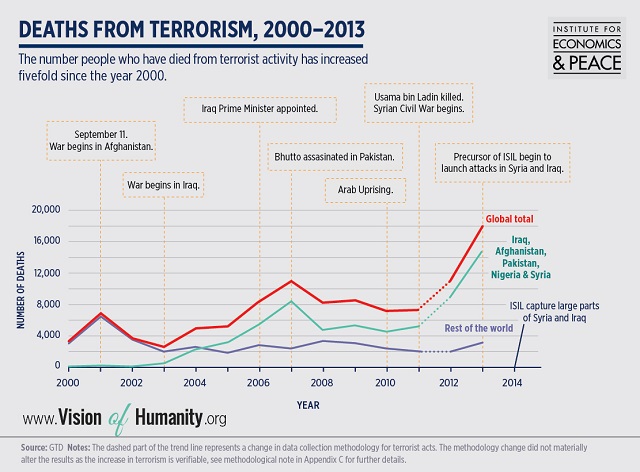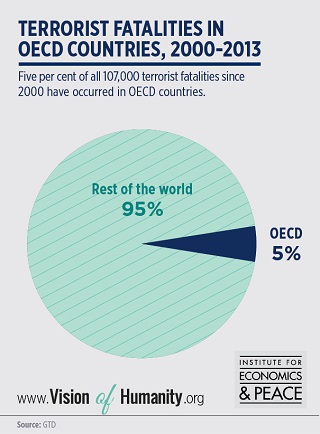Terrorism in Numbers
Is the number of people dying from terrorist activity increasing? Are you more likely to be killed by terrorism than homicide? Which are the 13 countries currently at risk of increased terrorist activity? The Institute for Economics and Peace’s Global Terrorism Index 2014 has the answers.
Over the past 15 years, terrorism has become one of the most prevalent threats to global peace. The Institute for Economics and Peace has just released the 2014 Global Terrorism Index to consider recent developments and changes in global terrorism.
The GTI ranks countries by the impact of terrorist activities and analyses the economic and social dimensions associated with terrorism. Last published in 2012, the GTI uses empirical research, applying quantitative data analysis to measure developments in global terrorism. The Index ranks 162 countries covering 99.6% of the world’s population, and examines trends from 2000 to 2013. It is comprised of 4 indicators: number of incidents, number of fatalities, number of casualties and level of property damage.

Image credit: Institute for Economics and Peace

Image credit: Institute for Economics and Peace
The Index found that the number of lives lost to terrorist attacks increased by over 60% in a single year, rising from 11,133 in 2012 to 17,958 in 2013. It also recorded a 44% increase in the number of terrorist incidents, rising from 6,825 in 2012 to 9,814 in 2013. 82% of all deaths from terrorist attacks in 2013 were in just five countries: Iraq, Afghanistan, Pakistan, Nigeria and Syria, Iraq the country most significantly impacted by terrorism with 2,492 attacks killing 6,362 people. Terrorism has also grown significantly in intensity and breadth outside of these five countries. In 2013 there were 3,721 attacks recorded in the rest of the world killing 3,236 people, an increase of over 50% year on year. A total of 60 countries recorded deaths from terrorist attacks in 2013. Since 2000, around 7% of all terrorist incidents and 5% of all fatalities have occurred in OECD countries resulting in 4,861 deaths from 3,151 attacks.
Institute research has identified three statistically significant factors which have historically been associated with terrorism. These are state sponsored violence, group grievances and high levels of criminality. The strong relationship between terrorism and other forms of violence underlines how the persistent targeting of police forces and the instability generated by terrorist activity can undermine the rule of law. Interestingly, poverty rates, levels of school attendance and most economic factors have no association with terrorism.
Based on this analysis, the GTI has identified 13 countries currently at risk of increased terrorist activity. They are Angola, Bangladesh, Burundi, Central African Republic, Cote d’Ivoire, Ethiopia, Iran, Israel, Mali, Mexico, Myanmar, Sri Lanka and Uganda.
Terrorism is not the greatest threat to global peace and stability, however. Many more people die in homicides than in terrorist attacks, with an individual 40 times more likely to be a victim of homicide than be killed by terrorism.
The Global Terrorism Index aims raise the level of debate about terrorism, giving both the public and policymakers a more sophisticated and comprehensive understanding of this issue. This will facilitate more effective responses and more practical solutions to global terrorism.
Camilla Schippa is Director of the Institute for Economics and Peace. To read the full report and explore the interactive maps visit: www.visionofhumanity.org


